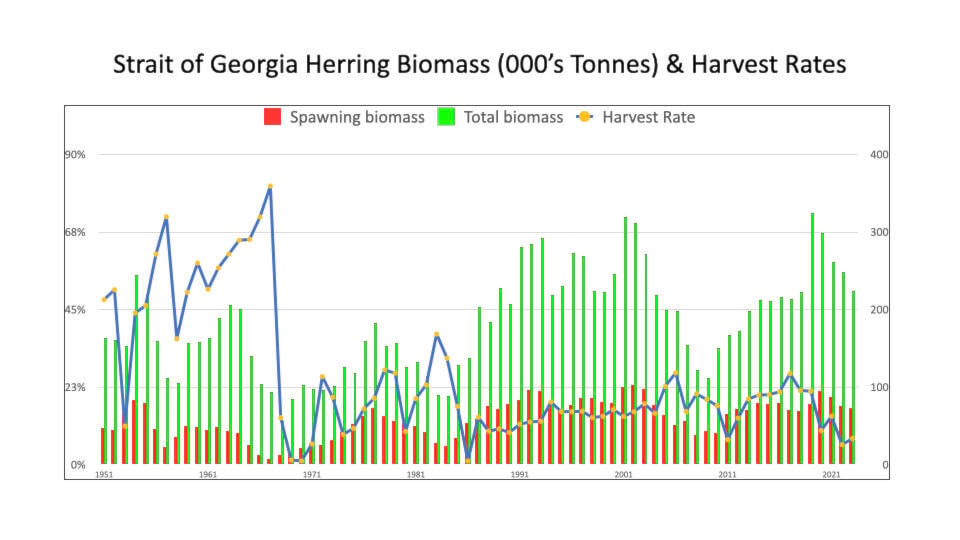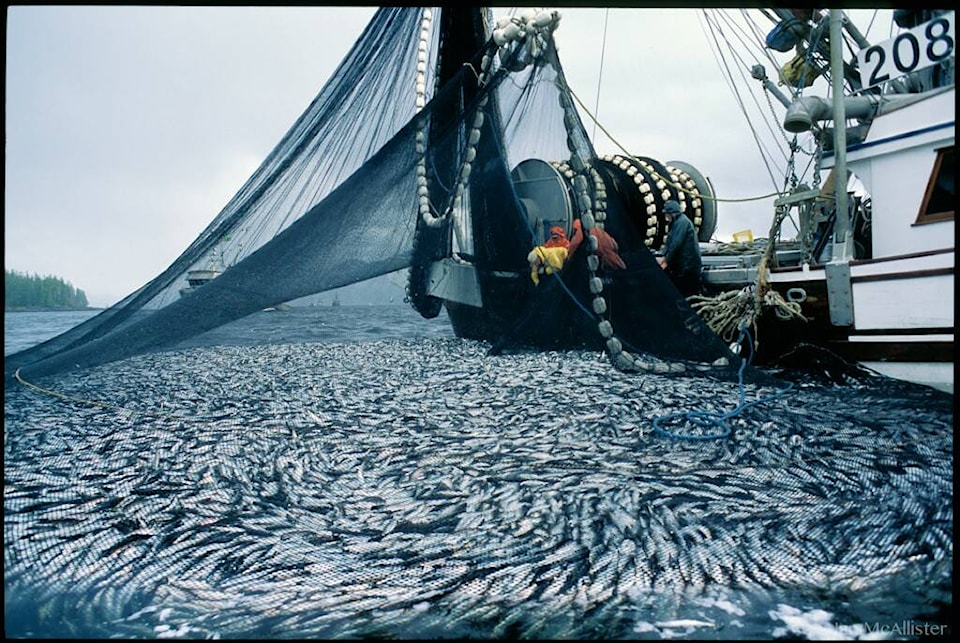Calls for a last-minute moratorium are intensifying as the start of Pacific herring season in the Straight of Georgia approaches on Nov.24.
Concerns are resurfacing among some citizens as they fear the potential impact of these fisheries on the province’s herring stock.
Fisheries and Oceans Canada’s (DFO) draft forecasted median spawning biomass of 80,288 tons in 2023 and 80,882 tons in 2024. This year’s harvest target may reach a maximum of 10 per cent of this said biomass, allowing fishermen to catch roughly 8,000 tons of herring. The Food and Bait, and Special Use fisheries, will be authorized to catch about 3,000 tons, while the remaining 5,000 tons will go to roe fisheries in early spring of next year.
According to Jim Shortreed, a Victoria-based herring enhancement volunteer, these numbers are unsustainable.
After noticing the disappearance of numerous herring spawns south of Nanaimo, causing DFO to close several tidal areas to commercial fisheries, the herring advocate called for an indefinite moratorium to help these fish repopulate their former ground.
Using the analogy of the canary in the coal mine, Shortreed warned communities north of Nanaimo of a plight potentially creeping northward, slowly making its way to the shores of the Comox Valley, recognized as B.C.’s Pacific herring stronghold.
Sydney Dixon, a marine specialist at Pacific Wild, shared Shortreed’s viewpoint and urged for a last-minute and indefinite moratorium.
“Our stance at Pacific Wild is we would like to see a complete (coast-wide) moratorium on Pacific herring in B.C. until our stocks have had time to recover,” said Dixon. “They’re at such a low biomass and spawning state right now.”
While Dixon acknowledged that these forage fish have fairly large fluctuations within their population every year due to a variety of different factors, she identifies herring fisheries as the number one culprit responsible for the species’ decline.
“I’m sure climate change probably does have an effect to some extent,” said Dixon. “ The level of natural predation has been higher in recent years as well as natural mortality. But overfishing is the number one cause for herring declining, not just in the SoG, but in British Columbia as a whole.”
Though the marine specialist recognized DFO’s decision to cut back harvest rates from 20 to 10 per cent since 2021 as a step in the right direction, she argued that this is not enough, reiterating the importance of an indefinite moratorium.
When asked about an estimated time for the suspension of these fisheries, Dixon provided no clear response.
“It’s really hard to say… It always depends, (since) the populations are always fluctuating,” said Dixon. “We want a moratorium sooner rather than later because if you hit that point of no return, it takes a lot longer for them to come back.”
Dixon further referenced a , which reported that 99 percent of the Salish Sea’s forage fish population, which includes the Pacific herring, disappeared within the first few decades of the arrival of European colonizers in the region. This occurred 60 years before any type of modern scientific documentation.
When asked what would be the ideal biomass, the marine specialist couldn’t define the exact number.
“The herring stock has declined so precipitously in the SoG that I think that our baseline is ‘a lot of fish’, (but this) is inaccurate in and of itself,” said Dixon. “I think only Indigenous knowledge can tell us what a healthy herring population looks like. Since we’ve had colonial fisheries here, it hasn’t been healthy really.”
The other side of the coin
Ronnie Chickite, elected Chief of the region’s We Wai Kai Nation and herring fisherman with nearly three decades of experience, disagreed with Dixon’s assessment.
“Absolutely not, I do not agree with (what Pacific Wild) is saying,” said Chickite. “This past year was probably the best fishing I’ve ever seen in the 29 years of me doing this job. I literally caught my quota in less than 12 hours… everybody around us was catching their quotas in record times.
“Even Ray Charles could have sat there and caught herring. (That goes) to show how good it was.”
Noting that roughly 50 percent of the commercial herring fishery licenses in the province are Indigenous-owned, the Chief stressed that a moratorium would deal a substantial economic blow to many coastal First Nations throughout the province that heavily rely on these fisheries.
“We should have a say, as Indigenous leaders, on what happens in our territory,” said Chickite. “An (indefinite) moratorium would decimate the First Nations involved in these fisheries. If we were seeing a decline, I would definitely be saying something… but these are the best (herring stocks) I’ve seen in 30 years.
“These (wildlife conservation) guys seem to be trying to push more of a narrative.”
Outside the context of First Nations, third-generation fisherman Lyle Pierce expressed his concern about the broader consequences of an indefinite moratorium. This measure could potentially sound the death knell for an entire industry that generated in B.C.’s coastal economy back in 2016.
“Without these fisheries, we’ve got no fish processing plants, no truckers, dying spin-off industries, and families without work,” said Pierce. “City people don’t (understand that’s) how we survive in these rural communities by either fishing, logging, or mining.”
Healthy numbers
Supporting Chickite and equally critical of Dixon and Shortreed’s claim is Robert Morley, the chair of the Herring Industry Advisory Board.
“The herring stocks in the SoG are as strong as they’ve ever been and over the last decade they’ve been growing,” said Morley who is also acting as the executive director of the Herring Conservation and Research Society. “The hard data that we’ve had to look at the stocks has been around since 1951. That’s… probably the longest string of scientific data collected as rigorously as that of almost any fishery in the world.”

Similar to Dixon, Morley acknowledged that herring populations fluctuate from year to year. However, he argued this natural variation in numbers should not be a cause for concern. Instead, the focus should be on how the data is interpreted.
“If we look at the total population, it is almost three times that amount (of the spawning population),” said Morley. “That’s a very large biomass that is out there to service the ecosystem.”
While herring advocates may contend that overfishing led to the decimation of local fish populations, Morley presents an alternative perspective.
He explained that the Pacific herring, primarily a migratory species, exhibits diverse spawning behaviours, influenced by numerous environmental factors such as increasing predation, pollution, and water temperature, as well as the disappearance of coastal eelgrass beds and suitable spawning grounds, among other variables.
This would potentially explain the closure of commercial herring fisheries south of Nanaimo, as Shortreed highlighted.
According to Morley, this trend is not exclusive to Vancouver Island; a similar phenomenon was observed in Washington State’s Puget Sound, which witnessed a decline in its herring population. He added that spawning locations have consistently changed over the last century.
Coincidentally, several uncommon herring spawnings have been observed across the province’s coastline in recent years, notably in Indian Arm, Burrard Inlet, Squamish, and Powell River noted Morley.
In light of this observation, he emphasized that fishing these smaller aggregates would make little to no economic sense. Given that roe fisheries occur over a few days, fishermen target the largest schools to optimize their catch.
Despite consistently observing steady healthy biomasses of these small forage fish, Morley criticized the decision of former DFO minister Joyce Murray to reduce the 2021/2022 harvest rate to 10 per cent.
“(The 20 per cent harvest rate) was based on the science that has shown to be acceptable and sustainable,” said Morley. “My understanding is that she didn’t trust her own scientist.
“The reality is that herring populations are healthy now and they would be assessed as healthy under any kind of scientific stock assessment. We have demonstrated that a 20 per cent harvest rate is sustainable and the stocks will continue to stay healthy.”
Both Chickite and Pierce concurred with this perspective.
Murray justified the cut back on Pacific herring fisheries, “intensified risks to wild salmon, for which herring is an important food source.” However, Morley notes that between the abundance of the salmon populations and B.C. herring stocks was established.
Moving forward
While Chickite, Morley, and Pierce unanimously agreed that herring fisheries do not currently pose a threat to this keystone species, all three acknowledged the harmful impacts of overfishing, which resulted in the herring collapse in the 60s.
Since then, the fishing industry has attempted to shed its negative reputation.
“(Nowadays) herring fisheries are heavily controlled and are fully monitored,” said Morley. “There are DFO patrol vessels on the (scene) observing all the activities and it’s happening in a relatively small area. They have over-flights that can see exactly what’s going on. You have to offload the herrings (in front of an) independent observer, counting the catch. We basically never go over the quota.”
And even if one could manage to make it through this seemingly airtight process, the risk of getting caught greatly outweighs the possibility of rapid financial gains.
“Under today’s quota systems, (no one is) interested in overfishing, getting sued, going to court, and having all their stuff seized. There’s no benefit to it,” added Pierce.
Beyond presenting a liability, Pierce emphasized that overfishing fundamentally conflicts with the fisherman’s livelihood by essentially endangering its own future.
“No fisherman wants the (herring stocks) to collapse,” said Pierce. “Why would we? Everything we own would be worthless. We would have no jobs. We couldn’t feed our families. No fishermen would want to overharvest.”
“Fishermen aren’t as greedy as people want to make us. We’re not that dumb. We want fisheries for 50 years down the road. That’s what it’s about: sustainable fisheries and feeding people.”
Yet, Pierce recognized that past abuses are complicated to exonerate.
“I’ll be honest… our industry as a whole never did its due diligence,” said Pierce. “We didn’t do a good job of educating the public on what we do with our fish, where it comes from, or how it’s managed.
“I think all fishermen have a feeling that they’re out there trying to put food on the table for Canadians.”
Since the 1960s, significant changes have occurred. In response to past exploitation, environmental voices emerged across the country, aiming to prevent future injustices. Coincidentally, fishing practices evolved, guided by increasingly rigorous scientific input and stringent governmental policies.
As Dixon proposed, perhaps now is the time to move on and pass the torch to our province’s First Nations, entrusting them with the future of herring fisheries.
“(People) need to trust Indigenous knowledge and understand the rights of Indigenous people as we are the stewards of the lands and ocean. (It’s our priority) to maintain sustainable stocks (for the benefit of) the overall ecosystem.”
NEWSLETTER:



